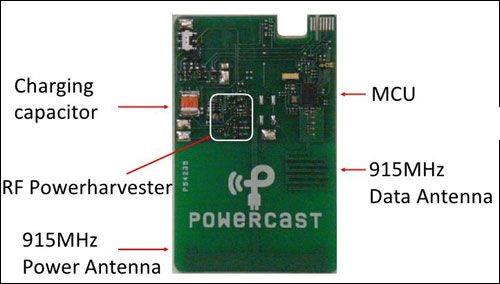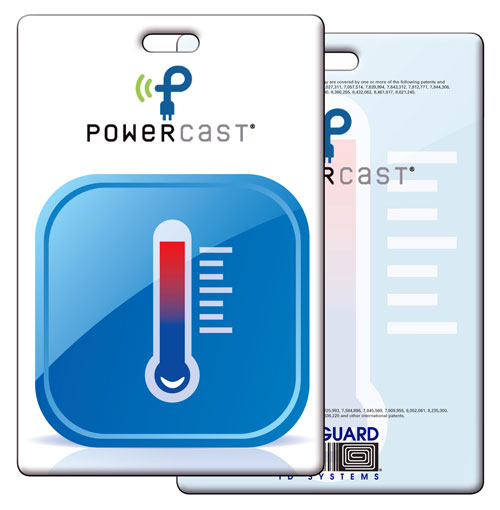Pennsylvania RFID firm Vanguard ID Systems is marketing a new EPC Gen 2 ultrahigh-frequency (UHF) RFID tag that can be read under harsh conditions, and provide sensor data about the environment. The tag, co-developed by wireless power and charging company Powercast Corp., is also available with a screen on which data can be updated visually.
The High Function tag was announced earlier this month at the RFID Journal LIVE! 2014 conference and exhibition, held in Orlando, Fla.

The inlays consist of an RFID chip and Powercast’s own integrated circuit for harvesting and distributing power to the chip, as well as sensors and a microcontroller. According to Alan Neves, Vanguard ID’s global RFID account manager, each inlay is protected by his company’s Teslin synthetic printing sheet that acts like miniature bubble wrap, and clear polyester layers protecting it from water or other liquids, as well as from extreme temperatures and impacts.
“We have partnered with Vanguard to provide waterproof packaging and the ability to have customer-specific graphics and branding,” says Charles Greene, Powercast Corp.’s CTO. Although Powercast designed the RFID inlay that Vanguard has packaged and will be selling, Powercast also has companies using its RF energy-harvesting technologies for other applications.
The High Function tag’s sensor options—such as temperature, vibration, tilt and humidity—can be customized according to a customer’s specific requirements.
The tag combines NXP Semiconductors‘ Ucode I²C RFID chip with Powercast’s RF-harvesting integrated circuit, which harvests enough energy from an interrogator to power the tag’s built-in microcontroller (MCU) and sensors for measuring conditions around the tag. The microcontroller then forwards that information to the Ucode RFID chip via the chip’s I²C interface, and the chip sends that data back to the reader via the EPC Gen 2 UHF RFID air-interface protocol.
According to Greene, Powercast and Vanguard ID developed the new tag as a higher-functioning model that does not require onboard batteries. Basic passive UHF tags are becoming more pervasive, he says, and are low-cost, yet their functionality is limited without a power source. Battery-powered tags tend to be too expensive for many applications, such as tracking the movements of cold-chain goods from a processing plant to a store. What’s more, they may not operate well under some extreme conditions, such as packed in ice. Compared with batteries, Greene says, Powercast’s RF energy-harvesting technology is less costly and less affected by extreme temperatures, while offering more than 10 times the operational power compared to standard passive RFID tags.
The High Function tag is designed for use under conditions in which tracking sensor data about goods is critical to ensure that they do not fall outside acceptable parameters. For example, perishable products may be packed in a container with dry ice. In this case, the High Function tag could be placed within that container, or be attached to its exterior, in order to monitor conditions inside the box. A reader’s RF signal would power the tag, and users could view the conditions on the reader’s screen and store that data in a company’s software. In that way, if temperatures fell or rose outside the acceptable parameters, workers at a distribution center, for example, could be alerted by reading the tag.
An interrogator would not require special software to read the sensor data, Greene says—it would simply read the tag’s user memory. “The data can be standard or customer-specific,” he states. The software could then issue alerts to management identifying a potential problem, as well as which container was in question and, thus, which product was at risk, packed inside that container.
In another use case, the High Function tag could be employed on machinery—within a manufacturing facility, for instance. In this scenario, the tag could measure vibrations and, when interrogated, transmit the collected vibration data that would indicate a potential problem with that piece of equipment before it actually failed. This, Greene says, would save the company the cost of having to shut down a manufacturing process in the event of a piece of equipment unexpectedly failing.
Retailers might be interested in deploying High Function tags with the electronic paper display option. The screen can display 28 characters or icons, but its size and other specifications would depend on an end user’s particular needs. In this case, a tag could be placed on a store shelf, and could display data regarding a product and its cost. That displayed information could then be changed via a transmission from an RFID read event.
Yet another use case would involve biometric proximity cards containing a fingerprint scanner. The card’s embedded High Function tag would utilize a reader’s power to scan a user’s fingerprint and transmit that data back to the interrogator.
The UHF tag can transmit a signal at a distance of about 25 feet using the High Function power-harvesting feature built into it. Vanguard ID also offers a version made with a high-frequency (HF) 13.56 MHz RFID chip, if requested, instead of the Ucode I²C chip.
Vanguard ID is offering a credit card-size version of the High Function tag, but it can also provide custom form factors as requested by customers. At least one firm is testing the tag now, Neves says, though he declines to indicate how the tag is being used, or that company’s name.


